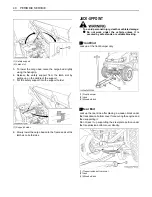
25
OPERATING THE VEHICLE
B
Driving through Water
To avoid personal injury:
A
Do not drive through water whenever it is
possible.
A
Drive slowly across shallow water and choose
a location to enter and exit the water where the
banks are not too steep or slippery.
A
Check before entering for rocks, holes or other
obstacles that may cause overturn, get stuck or
submerged.
A
Never operate the vehicle in fast flowing water
or in excess of 6 inches (152 mm) in depth.
Tires may float, making it difficult to maintain
control.
A
Wet brakes may reduce the stopping ability of
the vehicle. After operating in water, always
apply the brakes to dry them out.
A
The brake that gets wet may wear out faster.
Check for brake wear more frequently if
operating in water often.
A
Do not drive through water whenever it is possible. If
the alternator drive belt becomes wet, slippage may
occur.
(1) Axle cap
Summary of Contents for RTV500
Page 13: ...5 SAFE OPERATION 1 Cardboard 2 Hydraulic line 3 Magnifying glass...
Page 14: ...SAFE OPERATION 6 7 DANGER WARNING AND CAUTION LABELS...
Page 15: ...7 SAFE OPERATION...
Page 16: ...SAFE OPERATION 8...
Page 18: ......
















































